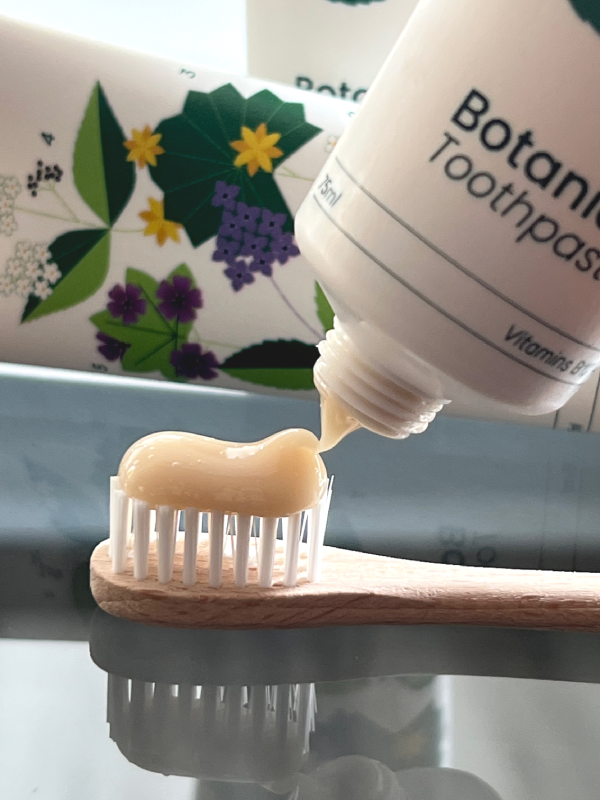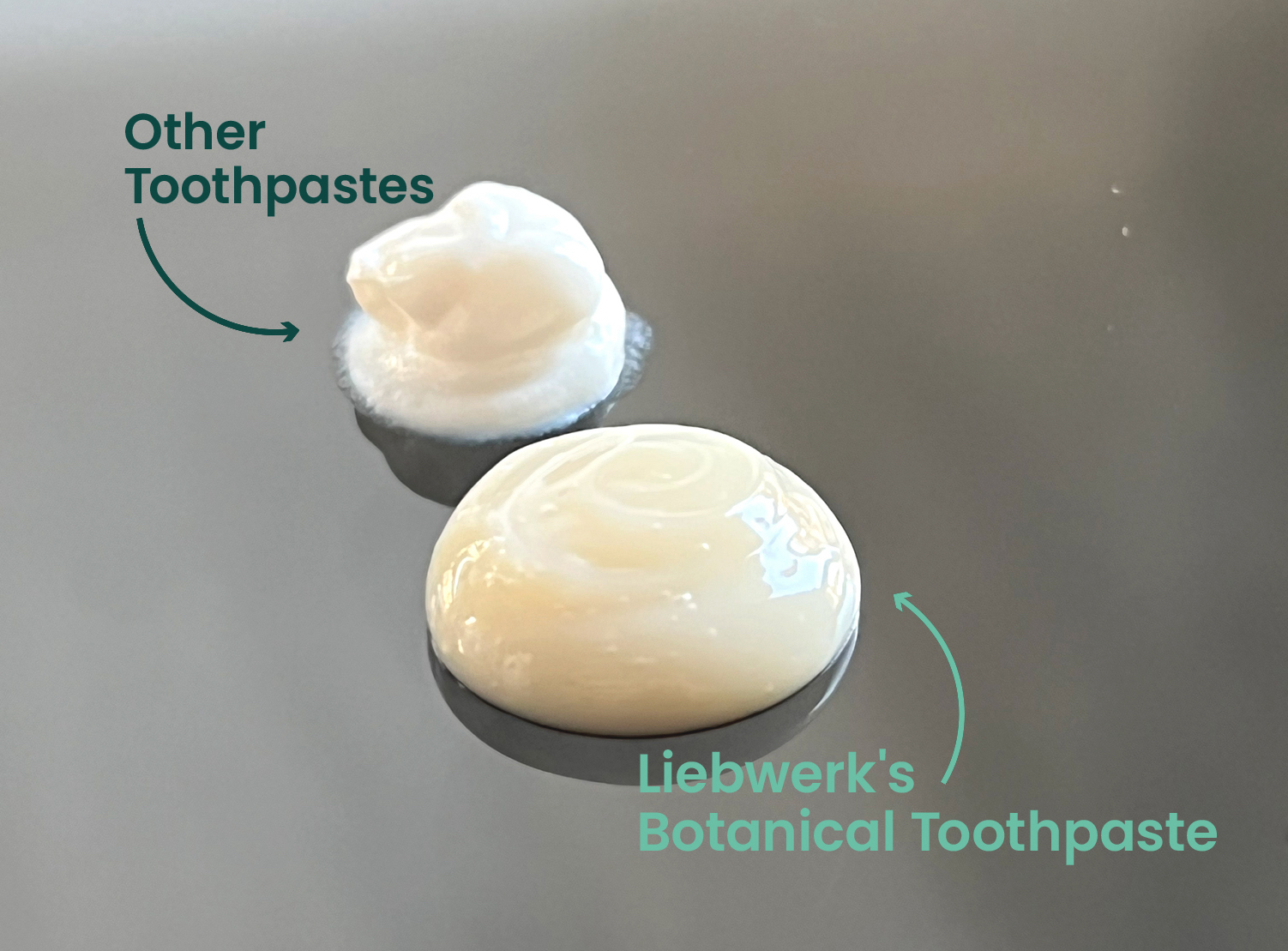Welche Zahnpasta passt zu mir? Überblick über Inhaltsstoffe, Arten und Pflege

Du fühlst dich bei der Wahl einer Zahnpasta von der Vielzahl an Optionen überfordert? Dann bist du hier genau richtig. Eine geeignete Zahnpasta auszuwählen, ist aufgrund der grossen Auswahl heutzutage zu einer echten Herausforderung geworden. Dieser Blogartikel soll dabei helfen, mehr über die verschiedenen Arten zu erfahren und schlussendlich die für dich richtige und beste Zahnpasta auszuwählen.
Von Fluorid bis Farbstoff - Die Inhaltsstoffe einer Zahnpasta einfach erklärt
Die wichtigsten Bestandteile einer Zahncreme sind Fluoride, Schleifmittel, Feuchthalte-, Reinigungs- und Bindemittel sowie Aroma-, Konservierungs-, Süss- und Farbstoffe. Um die Inhaltsstoffe einer Zahnpasta zu verstehen, sollten wir ihre unterschiedlichen Funktionen näher betrachten.
1. Fluorid
Der wahrscheinlich wichtigste Inhaltsstoff einer Zahnpasta ist Fluorid. Seine Aufgabe ist es, den Zahnschmelz, also die äusserste Schicht der Zähne, zu stärken und somit Karies vorzubeugen. Das Fluorid verbindet sich mit dem Kalzium im Zahnschmelz und bildet eine Schutzschicht, die von den Säuren der Mundbakterien nur schwer aufgelöst werden kann. Typischerweise enthält eine Zahnpasta 1000 bis 1500 ppm Fluorid.
2. Schleifmittel (Abrasiva)
Für eine optimale Wirkung enthält die Zahnpasta milde Schleifmittel, sogenannte Abrasiva. Die häufigsten abrasiven Inhaltsstoffe sind Kaliumcarbonat, Natriumcarbonat und hydratisierte Kieselsäure.
3. Reinigungsmittel
Das Reinigungsmittel in der Zahnpasta sorgt, wie auch andere Reinigungsmittel, für eine schäumende Wirkung. Dadurch lassen sich Ablagerungen auf den Zähnen leichter entfernen, da die Oberflächenspannung reduziert wird. Der für diesen Zweck häufigste Inhaltsstoff der Zahnpasta ist Natriumlaurylsulfat.
- Feuchthaltemittel: Feuchthaltemittel sorgen dafür, dass die Zahnpasta ihre halbflüssige Konsistenz behält und an der Luft nicht austrocknet. Dazu werden Sorbitol und andere Glykole verwendet
- Bindemittel: Wie der Name schon sagt, verbindet das Bindemittel die festen und flüssigen Zutaten miteinander. Hierzu werden überwiegend natürlich vorkommende Verdickungsmittel wie Xanthan, Arabicum und Traganth verwendet
- Aromastoffe: Man findet sie unter diesem Namen auch auf dem Etikett. Ihr einziger Zweck ist die Verbesserung des Geschmacks der Zahnpasta
- Konservierungsstoffe: Wie andere Konservierungsmittel verhindern diese das Verderben, in unserem Fall der Zahnpasta, und erhöhen so die Haltbarkeit. Sie können unter dem Namen Methylparaben oder Hydroxylbenzoat gefunden werden
- Süssstoff: Als Süssungsmittel fungiert Sorbitol, das auch als Feuchthaltemittel verwendet wird. Einige andere Beispiele sind Saccharin, Stevia und Xylitol. Letzteres hat zusätzlich die Eigenschaft, Karies vorzubeugen
- Farbstoffe: Das Titanoxid, das auf dem Etikett der Zahnpasta zu finden ist, verleiht ihr die typische weisse Farbe
Welche Zahnpasta-Arten gibt es?
Nicht nur das Kleingedruckte auf dem Zahnpasta-Etikett ist verwirrend, auch in den Regalen gibt es zahlreiche „spezielle“ Zahnpasten, die angeblich aufgrund von zusätzlichen Inhaltsstoffen besser sein und bestimmte Munderkrankungen bekämpfen sollen. Die folgende Auflistung soll helfen, den Unterschied und die Grundprinzipien der verschiedenen Zahnpasten zu verstehen:
- Zahnpasta für empfindliche Zähne: Zähne werden aus zwei Gründen empfindlich: Entweder ist der Zahnschmelz durch zu starkes Putzen der Zähne oder säurehaltige Nahrung dünner geworden, oder das Zahnfleisch hat sich zurückgezogen und die Zahnwurzel freigelegt. In beiden Fällen wird Dentin freigelegt, die Schicht unter dem Zahnschmelz. Dentin enthält Nervenenden, die die Zähne empfindlich auf Temperaturveränderungen reagieren lassen. Typischerweise blockiert eine Zahnpasta für empfindliche Zähne diese Nervenenden und somit das Schmerzempfinden. Allerdings sollte man Zahnfleischprobleme nicht allzu lange ignorieren, da solche Zahnpasten keine dauerhafte Lösung für Zahnerkrankungen darstellen.
- Zahnpasten zur Zahnaufhellung: Zahnpasten für weisse Zähne scheinen die kostengünstigste Option für eine Zahnaufhellung zu sein. Die meisten Whitening Zahnpasten enthalten jedoch kein Peroxid – also Bleichmittel. Tatsächlich ist in diesen Zahnpasten mehr Schleifmittel enthalten, die auf lange Sicht die Zähne schädigen können. Wenn man sich für eine Zahnpasta für weissere Zähne entscheidet, sollte man eine aufhellende Zahnpasta wählen, die Zahnverfärbungen bekämpft. Beachte: Keine Zahnpasta kann den gleichen Aufhellungseffekt erreichen, den eine Bleaching-Behandlung beim Zahnarzt erzielen kann.
- Zahnpasten zur Zahnsteinbekämpfung: Zahnstein ist verhärteter Zahnbelag, der sich auf den Zähnen bildet. Fast jede Zahncreme enthält Anti-Zahnstein-Wirkstoffe wie Xanthan, die helfen, den Zahnstein im Speichel zu binden und zu verhindern, dass er sich an den Zähnen festsetzt.
- Pflanzliche/natürliche Zahnpasten: Für Naturliebhaber sind solche Zahnpasten oft die erste Wahl, da sie auf natürlichen Inhaltsstoffen basieren und umweltfreundlich erscheinen. Doch die überraschende Wahrheit ist, dass in den meisten natürlichen Zahnpasten das wichtige Fluorid fehlt. Ohne Fluorid ist die Wirksamkeit bei der Kariesvorbeugung stark eingeschränkt, da das wichtigste Mittel gegen Karies fehlt. Auch wenn Zahnpasten ohne Fluorid antibakterielle Kräuter enthalten, bieten sie, im Gegensatz zu Fluorid-Zahnpasten, keinen vergleichbaren Schutz gegen Karies. Einige natürliche Zahncreme enthalten zwar geringe Mengen an Fluorid, sind aber weniger wirksam, da mindestens 1000 ppm Fluorid erforderlich sind, um Karies wirksam vorzubeugen.
- Kinderzahnpasta: Kinder- und Babyzahnpasta enthält normalerweise etwa 600 ppm Fluorid. Für Kinder zwischen 18 Monaten und 6 Jahren sollte nur eine erbsengrosse Menge verwendet werden, und für Kleinkinder unter 18 Monaten wird Fluorid nicht empfohlen. Achten Sie auf den Fluoridgehalt und lassen Sie Ihre Kinder eine Zahncreme mit ihrer Lieblingsgeschmacksrichtung und -figur auswählen.

5 Tipps für die Wahl der richtigen Zahnpasta
Da wir nun die grundlegenden Bestandteile einer klassischen und die Besonderheiten von speziellen Zahnpasten kennen, ist es einfacher, die richtige Zahncreme auszuwählen:
- Lese die Packungsbeilage und wähle eine Zahnpasta mit der richtigen Menge Fluorid
- Verwende morgens eine von dir bevorzugte Kräuterzahnpasta und abends eine fluoridhaltige, um die Zähne über Nacht vor Bakterien zu schützen
- Wähle eine aufhellende Zahnpasta zur Fleckenentfernung anstelle von solchen mit hohem Schleifmittelanteil
- Verwende Zahnpasten gegen Schmerzempfindlichkeit, wenn ein Zahnarzt dies empfohlen hat. Das ersetzt allerdings keine zahnärztliche Behandlung
- Und denk daran, dich von deinem Zahnarzt beraten zu lassen, bevor du dich für eine spezielle Zahnpasta entscheidest
Egal welche Zahnpasta man verwendet, die Zahnpflege ist nur dann effektiv, wenn man auch die Regeln für gute Mundhygiene beachtet.
Deshalb sollten Fluorid-Zahnpasten zusammen mit einer guten Zahnbürste verwendet werden. Die tägliche Verwendung von Zahnseide und eine gesunde Ernährung sind ebenfalls wichtig für gesunde Zähne und ein strahlend weisses Lächeln.
